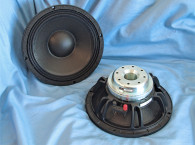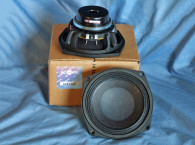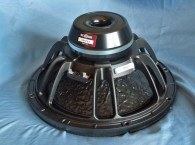
Features for the 8MBX51 are fairly impressive. Starting with the frame, B&C Speakers has come up with a proprietary four twin-spoke cast-aluminum frame incorporating eight 30 mm × 2.5 mm rectangular vent holes in the area below the spider mounting shelf for enhanced voice coil cooling. This series of cooling vents moves air past the voice coil and across the front of the neodymium motor assembly.
The cone assembly consists of a curvilinear paper cone with a front side waterproof hydrophobic coating and a 3.5” diameter inverted paper dust cap, also with a waterproof hydrophobic coating. Compliance is provided by a triple roll “M”-shaped pleated coated cloth surround while the remaining compliance comes from a 4” diameter flat cloth spider.
The 8MBX51’s motor design utilizes a neodymium ring magnet, T-shaped pole piece fitted with an aluminum shorting ring located below the yoke (Faraday Shield). The neodymium ring magnet motor was FEA designed using a 51 mm (2”) diameter voice coil inside/outside (one layer wound on the inside of the former and one layer wound on the outside of the former) with round copper-clad aluminum wire (CCAW) on a non-conducting glass fiber former.
The motor parts, the return cup, and the front plate are coated with a black heat-emissive coating for improved cooling. The cooling is further enhanced by six 4 mm diameter peripheral vents and a 20 mm diameter pole vent on the back side of the return cup. Last, the voice coil is terminated to an injection-molded terminal block with solderable terminals. Cosmetically speaking, this is good looking driver (see Photo 1).





I used the LinearX LMS analyzer and VIBox to create the voltage and the admittance (current) curves with the driver clamped to a rigid test fixture in free air at 0.3, 1, 3, 6, 10, 15, and 20 V. The driver remained acceptably linear for LEAP 5 to curve fit at 20 V, which, like last month’s Wavecor’s SW223BD03, is good for any 8” woofer.
Following my established Test Bench protocol, I no longer use a single added mass measurement. Instead, I use the physically measured Mmd data (18.1 grams for the 8MBX51). I post-processed the collected data—the 14 550-point stepped sine wave sweeps for each 8MBX51 sample—and divided the voltage curves by the current curves to generate impedance curves.
I derived the phase using the LMS calculation method and imported the data, along with the accompanying voltage curves, to the LEAP 5 Enclosure Shop software. Because the Thiele-Small (T-S) data provided by the majority of OEM manufacturers is generated using either the standard model or the LEAP 4 TSL model, I used the 1 V free-air curves to also created a LEAP 4 TSL parameter set. I selected the complete data set, the multiple voltage impedance curves for the LTD model, and the 1 V impedance curve for the TSL model in the transducer parameter derivation menu in LEAP 5 and created the parameters for the computer box simulations. Figure 1 shows the 1 V free-air impedance curve. Table 1 compares the LEAP 5 LTD and TSL data and factory parameters for both of 8MBX51 samples.
The LEAP parameter calculation results correlated with the published factory data, except for the XMAX number. With a published gap height of 7 mm and winding height of 15 mm, the published data is likely just a typo. Given this is a new product and the data is preliminary, this occasionally occurs. However, I followed my usual protocol and proceeded to set up computer enclosure simulations using the LEAP LTD parameters for Sample 1. I programmed two computer box simulations into LEAP 5. One was the factory recommended vented box with a 0.67-ft3 volume (15% fill material) tuned to 63 Hz. The other was a sealed enclosure with a 0.12-ft3 volume simulated with 50% fiberglass damping material.
Figure 2 displays the results for the 8MBX51 in the two enclosures at 2.83 V and at a voltage level sufficiently high enough to increase cone excursion to 4.6 mm (XMAX + 15%). This produced a F3 frequency of 56 Hz (F6 = 51 Hz) for the factory recommended enclosure (kind of an Extended Bass Shelf-type alignment) and –3 dB = 166 Hz (F6 = 133 Hz) for the sealed box simulation. Increasing the voltage input to the simulations until the maximum linear cone excursion was reached resulted in 116 dB at 31 V for the factory recommended box and 120 dB for a 36 V input level for the smaller sealed box.
Figure 3 shows the 2.83 V group delay curves. Figure 4 shows the 31 V/36 V excursion curves. With the vented factory box, excursion goes beyond the 4.6 mm (XMAX + 15%) to around 53 Hz, so a 45 to 50 Hz steep (24 dB/octave) high-pass filter would be a useful addition to this alignment. Patrick Turnmire, of Redrock Acoustics, performed the Klippel analysis for 8MBX51, which produced the Bl(X), KMS(X), and Bl and KMS symmetry range plots given in Figures 5–8. (Our analyzer is provided courtesy of Klippel GmbH.)




The Bl(X) curve for the 8MBX51 (see Figure 5) is moderately broad and nicely symmetrical, with a small amount of offset. Looking at the Bl symmetry plot (see Figure 6), this curve shows a small 0.57 mm coil-out offset at the 2.5 mm position (an area of reasonable certainty) increasing to a likewise trivial 0.41 mm coilout offset at the physical position that stays relatively constant throughout the remaining operating range of the driver.
Figure 7 shows the KMS(X) curve, which is also fairly symmetrical in both directions, as well as having an obvious, but not large offset. Figure 8 shows the KMS symmetry range plot, with a 0.47 mm coil-in offset 1 mm (a area of reasonable certainty, indicated by the shaded grey area) staying more or less constant out to the physical XMAX, where it increases slightly to 0.54 mm. The 8MBX51’s displacement limiting numbers (calculated by the Klippel analyzer) were XBl at 82% Bl = 4.2 mm and for crossover (XC) at 75% CMS minimum was 2.2 mm, which means that for the 8MBX51, the compliance is the most limiting factor for prescribed distortion level of 10%. Again, 10% may be a somewhat conservative criteria given the relative difficulty of perceiving total harmonic distortion (THD) subjectively, so if we apply the 20% distortion criteria with Bl decreasing to 70% and compliance decreasing to 50%, then the numbers are XBl = 5.2 mm and XC = 4 mm.




Figure 9 gives the 8MBX51’s inductance curves Le(X). Inductance will typically increase in the rear direction from the zero rest position as the voice coil covers more pole area, which is what is happening here. However, with an aluminum shorting ring installed in the 8MBX51, the inductance swing is a maximum of 0.063 mH, which is very good for minimizing distortion.
With the Klippel testing completed, I mounted the 8MBX51 woofer in a foam-filled enclosure that had a 15” × 8” baffle. Next, I used the LinearX LMS analyzer set to a 100-point gated sine wave sweep and measured the device under test (DUT) on and off axis from 300 Hz to 20 kHz at 2.83 V/1 m.
Figure 10 gives the 8MBX51’s’s on-axis response indicating a smoothly rising response that is ±2.6 dB from 500 Hz to 2.4 kHz, with some minor peaking as the driver begins its low-pass rolloff. Figure 11 displays the on- and off-axis frequency response at 0°, 15°, 30°, and 45°, showing the typical directivity for an 8” woofer. Figure 12 gives the normalized rendition of Figure 11, while Figure 13 displays the CLIO horizontal polar plot (in 10° increments).




For the remaining tests, I again employed the Listen SoundCheck AmpConnect analyzer and the SCM microphone to measure distortion and generate timefrequency plots. For the distortion measurement, I mounted the 8MBX51 rigidly in free-air, and set the SPL to 104 dB at 1 m (7.51 V), using a pink noise stimulus. I measured the distortion with the Listen microphone placed 10 cm from the driver. Figure 14 shows the distortion curves.
I then used SoundCheck to get a 2.83 V/1 m impulse response and imported the data into Listen’s SoundMap Time/Frequency software. Figure 15 shows the resulting CSD waterfall plot. Figure 16 shows the Wigner-Ville plot (which I used for its better low-frequency performance).
When you are dealing with a competent OEM such as B&C Speakers, you expect superior consistency and design integrity, which is what we see in the data for the B&C Speakers 8MBX51. For more information, visit www.bcspeakers.com. In the US, contact Bennett C. Prescott, B&C Sales and Operations manager for North America at (973) 248-0951, or by email. VC
This article was originally published in Voice Coil, November 2016.







